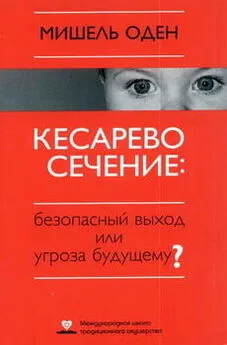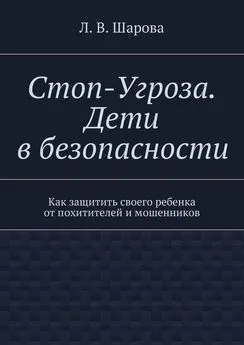Мишель Оден - КЕСАРЕВО СЕЧЕНИЕ: Безопасный выход или угроза будущему?
- Название:КЕСАРЕВО СЕЧЕНИЕ: Безопасный выход или угроза будущему?
- Автор:
- Жанр:
- Издательство:Международная школа традиционного акушерства
- Год:2006
- Город:Москва
- ISBN:5-9900577-1-7
- Рейтинг:
- Избранное:Добавить в избранное
-
Отзывы:
-
Ваша оценка:
Мишель Оден - КЕСАРЕВО СЕЧЕНИЕ: Безопасный выход или угроза будущему? краткое содержание
В этой книге выдающийся французский акушер-гинеколог Мишель Оден касается самых насущных вопросов современной акушерства.
Автор возвращает нас к ключевым потребностям женщины в родах, осознание которых позволяет сделать легкие и безопасные роды через естественные пути общераспространенным явлением. Ученый и врач с полувековой практикой, Оден приводит ценнейшие практические рекомендации, позволяющие этого достичь. Он также рассматривает в свете последних научных исследований вопросы ведения беременности, подготовки к родам, участия в родах отцов, грудного вскармливания.
Автор подробно рассматривает историю операции кесарева сечения, анализирует изменения, которые произошли за последние пятьдесят лет в практике родовспоможения. Общество свыклось с мыслью о легкости и безопасности родов посредством операции: сегодня так рождается почти каждый четвертый ребенок в мире. Автор убедительно развеивает миф о том, что рождение кесаревым сечением не сказывается на психическом и физическом здоровье ребенка в будущем. Анализируются перспективы развития человеческой цивилизации в случае следования по этому пути.
Книга предназначена для врачей акушеров-гинекологов, семейных врачей, акушерок студентов медицинских институтов и колледжей, а также для родителей и широкого круга читателей, интересующихся вопросами беременности, подготовки к родам и деторождения, материнства и современного акушерства. Она поможет сделать выбор тем, кто решает для себя вопрос, где и каким образом рожать, для того чтобы впоследствии мать и дитя были здоровы.
КЕСАРЕВО СЕЧЕНИЕ: Безопасный выход или угроза будущему? - читать онлайн бесплатно ознакомительный отрывок
Интервал:
Закладка:
21
Mongelli M, Kwan Y, et al. Effect of labour and delivery on plasma hepatic enzymes in the newborn. J. Obstet. Gynecol. Res. 2000; 26(1): 61-3.
22
Miclat NN, Hodgkinson R, Marx GT. Neonatal gastric pH. Anesth. Analg. 1972; 57(1): 98-101.
23
Lie B, Juul J. Effect of epidural vs. general anesthesia on breastfeeding. Acta Obstet. Gynecol. Scand. 1988; 67:207-9.
24
Almeida JAG. Breastfeeding: a nature-culture hybrid. Editora Fiocruz. Rio de Janeiro 2001.
25
Brasil/MS, 2000. Prevalencia do Aleitamento Materno nas Capitals Brasileiras e no Distrito Federal. Relatorio Preliminar, Versao 3, Brasilia, Ministerio da Saude.
26
Marques NM, Lira PI, da Silva NL, et al. Breastfeeding and early weaning practices in northeast Brazil: longitudinal study. Pediatrics 2001; 108 (4): E66.
27
Shawky S, Abalkhail BA. Maternal factors associated with the duration of breastfeeding in Jeddah, Saudi Arabia. Paediatr. Perinat. Epidemiol. 2003; 17(1): 91-6.
28
Martin J. Infant feeding 1975: attitudes and practice in England and Wales. OCPS. Social Survey Division. London, HMSO, 1978.
29
Doganay M, Avsar E Effects of labor time on secretion time and quantity ofbreastmilk. Int.J. Gynaecol. Obstet. 2002; 76(2); 207-11.
Глава 13
1
Morris S, Stacey M. Resuscitation in pregnancy. BMJ 2003; 327:1277-79.
2
Smith GCS, Pell JP, Dobbie R. Caesarean section and risk of unexplained stillbirth in subsequent pregnancy. Lancet 2003; 362:1779-84.
3
McKenna DS, Ester JB, Fischer JR. Elective cesarean delivery for women with aprevious sphincter rupture. Am.J. Obstet. Gynecol. 2003; 189(5):1251-6.
4
Hannah ME, Hannah WJ, et al. Planned caesarean section versus planned vaginal birth for breech presentation at term: a randomised multicentre trial. Lancet 2000; 356: 1375-83.
5
Odent M. Home breech birth. The Practising Midwife 2003; 6(1): 11.
6
Odent M. The fetus ejection reflex. Birth 1987; 14:104-5.
7
Elizabeth Noble. Having twins — and more. Third edition. Houghton Mifflin Company 2003.
8
Dominguez K, Lindegren ML, LAlmada PJ, et al. Increasing trend of cesarean deliveries in HIV-infected women in the United States from 1994 to 2000. /. Acquir. Immune Defic. Syndr. 2003; 33(2): 232-8.
Глава 14
1
Craigin EB. Conservatism in obstetrics. NY Med. J. 1916; 104:1-3.
2
National Institutes of Health. Cesarean childbirth. NIH publication no. 82-2067. Washington (DC): Government Printing Office, 1981.
3
Flamm BL, Newman LA, Thomas ST, Fallon D, Yoshida MM. Vaginal birth after cesarean delivery: Results of a 5-year multicenter collaborative study. Obstet. Gynecol. 1990; 76: 750-4.
4
Rosen MG, Dickinson JC, WesthofFCL Vaginal birth after cesarean: A meta-analysisof morbidity and mortality. Obstet Gynecol 1991; 77:465-70.
5
Flamm BL, Goings JR, Liu Y, Wolde-Tsadik G. Elective repeat cesarean delivery versus trial of labor: A prospective multicenter study. Obstet. Gynecol 1994; 83:927-32.
6
Menacker F, Curtin SC. Trends in cesarean birth and vaginal birth after previous cesarean, 1991-99. National Vital Statistics Reports 2001; 49 (13): 1-15.
7
Nat. Vtt. Stat. Rep. 2003; 51 (11): 1-20.
8
American College of Obstetricians and Gynecologists. Vaginal birth after previous cesarean delivery. Practice Bulletin No. Washington (DC): ACOG, 1999.
9
Troyer LS, Parisi VM. Obstetric parameters affecting success in trial of labor: Designation of a scoring system. Am. J. Obstet. Gynecol. 1992; 167:1099 —1104.
10
Weinstein D, Benshushan A, Tanos V, Zilberstein R, Rojansky N. Predictive score for vaginal birth after cesarean section. Am. J. Obstet. Gynecol. 1996; 174:192-8.
11
Flamm BL, Geiger AM. Vaginal birth after cesarean delivery: An admission scoring system. Obstet. Gynecol. 1997; 90: 907-10.
12
Lieberman E, Ernst EK, Rooks JP, Stapleton S. Results of the National study of vaginal birth after caesarean in birth centres. Obstet. Gynecol. 2004; 104:933-42.
13
Ravasia DJ, Wood SL, Pollard JK. Uterine rupture during induced trial of labor among women with previous cesarean delivery. Am. J. Obstet. Gynecol. 2000; 183(5): 1176-9.
14
Lydon-Rochelle M, Holt VL, Easterling TR, Martin DP. Risk of uterine rupture during labor among women with prior cesarean delivery. N. Engl. J. Med. 2001; 345(1): 54-55.
15
Smith GCS, Pell JP, Pasupathy D, Dobbie R. Factors predisposing to perinatal death related to uterine rupture during attempted vaginal birth after caesarean section: retrospective cohort study. BMJ 2004; 329: 375-7.
16
Gregory KD, Korst LM, Cane P, Piatt LD, Kahn K. Vaginal birth after cesarean and uterine rupture rates in California. Obstet. Gynecol. 1999; 94:985-9.
17
Rageth JC, Juzi C, Grossenbacher H. Delivery after previous cesarean: A risk evaluation. Obstet. Gynecol. 1999; 93: 332-7.
18
McMahon MJ, Luther ER, Bowes WA, Olshan AF. Comparison of a trial of labor with an elective second cesarean section. N. Engl. J. Med. 1996; 335:689-95.
19
Shipp TD, Zelop C, Repke JT, Cohen A, Caughey AB, Lieberman E. The association of maternal age and symptomatic uterine rupture during a trial of labor after prior cesarean delivery. Obstet. Gynecol. 2002; 99: 585-8.
20
Shipp TD, Zelop C, Cohen A, Repke JT, Lieberman E. Post-cesarean delivery fever and uterine rupture in a subsequent trial of labor. Obstet. Gynecol. 2003; 101:136-9.
21
Shipp TD, Zelop CM, Repke JT, Cohen A, Lieberman E. Interdelivery interval and risk of symptomatic uterine rupture. Obstet. Gynecol 2001; 97:175-7.
22
Chapman SJ, Owen J, Hauth JC. One—versus two-layer closure of a low transverse cesarean: The next pregnancy. Obstet. Gynecol. 1997;89:16-8.
23
Bujold E, Bujold C, Hamilton EF, Harel F, Gauthier RJ. The impact of a single-layer or double-layer closure on uterine rupture. Am. J. Obstet. Gynecol. 2002; 186: 1326-30.
24
Durnwald C, Mercer B. Uterine rupture, perioperative and perinatal morbidity after single-layer and double-layer closure at cesarean delivery. Am. J. Obstet. Gynecol. 2003; 189:925-29.
25
Bujold E, Gauthier RJ. Neonatal morbidity associated with uterine rupture: What are the risk factors? Am. J. Obstet. Gynecol. 2002; 186: 311-4.
26
Smith GCS, Pell JP, Cameron AD, Dobbie R. Risk of perinatal death associated with delivery after previous caesarean section. JAMA 2002; 287:2684-90.
27
Smith GCS, Pell JP, Dobbie R. Caesarean section and risk of unexplained stillbirth in subsequent pregnancy. Lancet 2003; 362:1779-84.
28
Landon MB, Hauth JC, Leveno KJ, et aL Maternal and perinatal outcomes associated with a trial of labor after prior cesarean delivery. N. EngL J. Med. 2004; 351(25): 2581-89.
Глава 16
1
Sarah Clement. The Caesarean experience. Pandora. London 1991.
2
Michele Moore, Caroline De Costa. Cesarean Section. Johns Hopkins 2003.
3
Nancy Wainer Cohen, Lois Estner. Silent knife. Bergin and Garvey 1983.
4
Lynn Baptisti Richards. The Vaginal Birth after Cesarean experience. Bergin and Garvey 1987.
5
Michel Odent. Birth Reborn. Pantheon. New York 1984.
6
Sylvie Donna. Baby.. .Be Born! In press.
7
Fisher J, Astbury J, Smith A. Adverse psychological impact of operative obstetrical intervention: a prospective longitudinal study. Australia New Zealand Journal of Psychiatry 1997; 31(5): 728-38.
Глава 17
1
Al-Mufti R, McCarthy A, Fisk NM. Obstetricians' personal choice and mode of delivery. Lancet 1996; 347: 544.
2
Rortveit G, Dalveit AK, Hannestad YS, Hunskaar S. Urinary incontinence after vaginal delivery or cesarean section. N. Engl. J. Med. 2003; 348: 900-7.
3
Goldberg RP, Kwon C, Gandhi S, Atkuru LV, Sorensen M, Sand PK. Urinary incontinence among mothers of multiples: the protective effect of cesarean delivery. Am. J. Obstet. Gynecol. 2003; 188(6): 1447-50.
4
Ryhammer AM, Век KM, Laurberg S. Multiple vaginal deliveries increase the risk of permanent incontinence of flatus and urine in normal premenopausal women. Dis. Colon Rectum 1995; 38:1206-9.
5
MacArthur C, Bick DE, Keigley MRB. Faecal incontinence after childbirth. Br. J. Obstet. Gynaecol. 1997; 104:46-50.
6
Sultan AH, Kamm MA, Hudson CN, Bartram CI. Third degree obstetric arid anal sphincter tears: risk factors and outcome of primary repair. BMJ 1994; 308:887-91.
7
Dietz HP, Bennett MJ. The effect of childbirth on pelvic organ mobility. Obstet. Gynecol. 2003; 102: 223-8.
8
Neill ME, Swash M. Increased motor unit fibre density in the external anal sphincter muscle in anorectal incontinence: a single EMG study. J. Neurol. Neuro-surg. Psychiat. 1980; 43: 343-47.
9
Sultan AH, Kamm MA, Hudson CN, Thomas JM, Bartram CI. Anal shincter disruption during vaginal delivery. N. Engl. J. Med. 1993; 329:1905-11.
10
Fynes M, Donnelly VS, O'Connell PR, O'Herlihy С Cesarean delivery and anal sphincter injury. Obstet. Gynecol. 1998; 92:496-500.
11
Odent M. The fetus ejection reflex. Birth 1987; 14:104-105.
12
Odent M. The Second stage as a disruption of the Fetus Ejection Reflex. Midw- iferyToday. Autumn 2002:12.
13
Ferguson JKW. A study of the motility of the intact uterus at term. Surg. Gyne col. Obstet. 1941; 73: 359-66.
Читать дальшеИнтервал:
Закладка:





